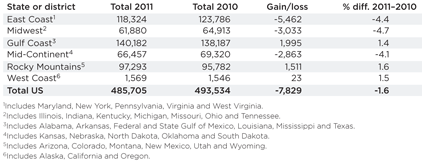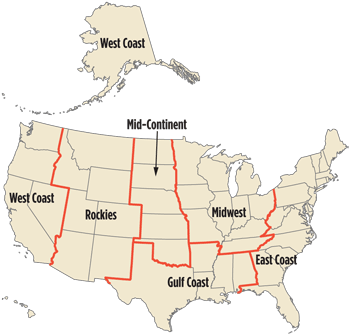2012 Forecast: U.S. gas well count declines as majority of rigs drill for oil
Henry Hub spot gas prices fell about 9% in 2011, to just short of $4/Mcf, reaching the second lowest annual average price since 2002. This drop has continued and accelerated the shift toward liquids-rich drilling, with the number of rigs targeting gas dropping 12.3% since 2010.
|
Henry Hub spot gas prices fell about 9% in 2011, to just short of $4/Mcf, reaching the second lowest annual average price since 2002. This drop has continued and accelerated the shift toward liquids-rich drilling, with the number of rigs targeting gas dropping 12.3% since 2010. For the first time since 1993, the oil rig count in North America has overtaken the number of rigs drilling for gas. Accordingly, the number of active, producing U.S. gas wells dropped 7,829 (down 1.6%), to end 2011 at a total of 485,705. This compares to a 2010 year-end total of 493,534 gas wells.
While pipeline disputes caused natural gas prices throughout 2011 to remain the highest in the Northeast—at around $5/Mcf—more than 75% of U.S. states saw a reduction in the number of active, gas-producing wells within their region. Both Kentucky and Pennsylvania saw the biggest drops, with a reduction of over 3,000 gas wells in each state. Despite these roughly 5% declines, both Pennsylvania and West Virginia continue to hold second and third place, respectively, for the largest number of active, gas-producing wells. Wyoming and Mississippi also experienced notable declines of 456 and 293 wells, respectively, as operators re-focused their efforts on liquids production. Texas remained the largest gas-producing state and saw a slight 1% increase in active gas wells throughout the year. The largest increase was in District 5 (865 wells), in the heart of the Barnett shale. District 6, in deep East Texas, remained the state’s leader in gas producing wells, followed closely by District 7C (West-Central Texas). Colorado, with a gain of 2,283 gas wells in 2011, is benefitting from the recent surge of activity in the Niobrara shale, which also contains high condensate and NGL content. Aside from Colorado, the biggest well gains came in five states Arkansas (up 881 gas wells), Alabama (plus 509 wells), Louisiana (up 502 wells), Virginia (plus 411 wells) and Michigan (up 300 wells).
On a regional basis, the Gulf Coast area had the most active gas wells at 140,182, up 1.4% from 2010’s figure. The East Coast was second at 118,324 (down 4.4%), followed by the Rocky Mountains (97,293, up 1.6%), Mid-Continent (66,457, down 4.1%), Midwest (61,880, down 4.7%) and West Coast (1,569, up 1.5%). On a gross withdrawal production basis, gas well productivity increased 7.9% last year. During 2011, output per well was 124,875 cfd, vs. 115,695 cfd in 2010. Despite the overall declining trend, the U.S. Energy Information Administration (EIA) estimates about 11.3 Bcfd of new natural gas pipeline capacity started commercial service in the United States during 2011. Some of the key pipeline expansions included the Ruby Pipeline, the Tennessee Line 300 project, and the Florida Gas Transmission Phase VIII Expansion project, which are expected to help maintain gas production levels in major gas-producing regions.
|
|||||||||||||||||
- Coiled tubing drilling’s role in the energy transition (March 2024)
- Using data to create new completion efficiencies (February 2024)
- Digital tool kit enhances real-time decision-making to improve drilling efficiency and performance (February 2024)
- E&P outside the U.S. maintains a disciplined pace (February 2024)
- Prices and governmental policies combine to stymie Canadian upstream growth (February 2024)
- U.S. operators reduce activity as crude prices plunge (February 2024)




